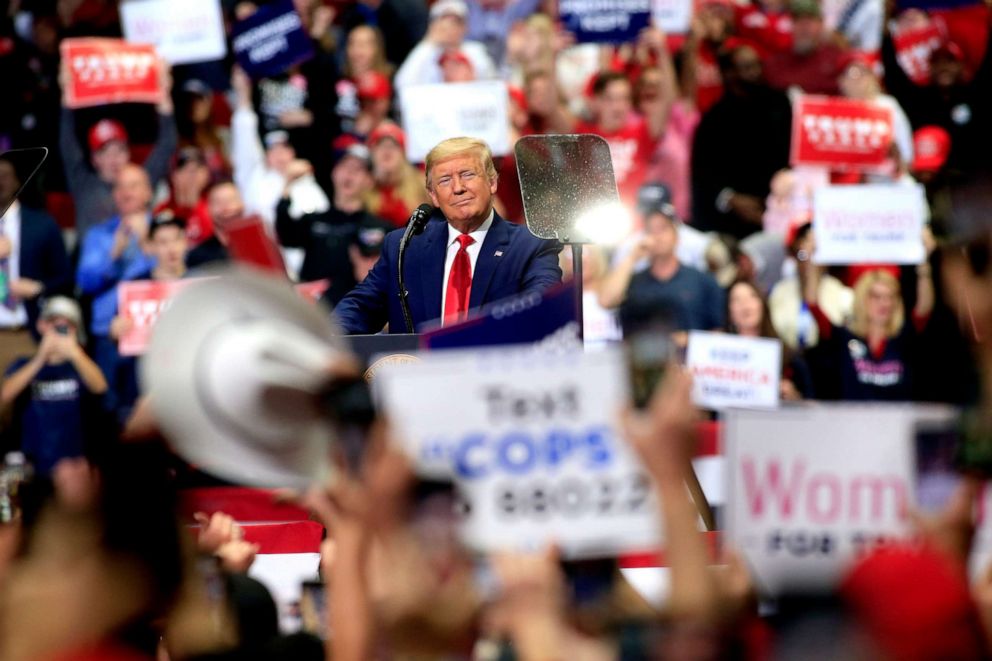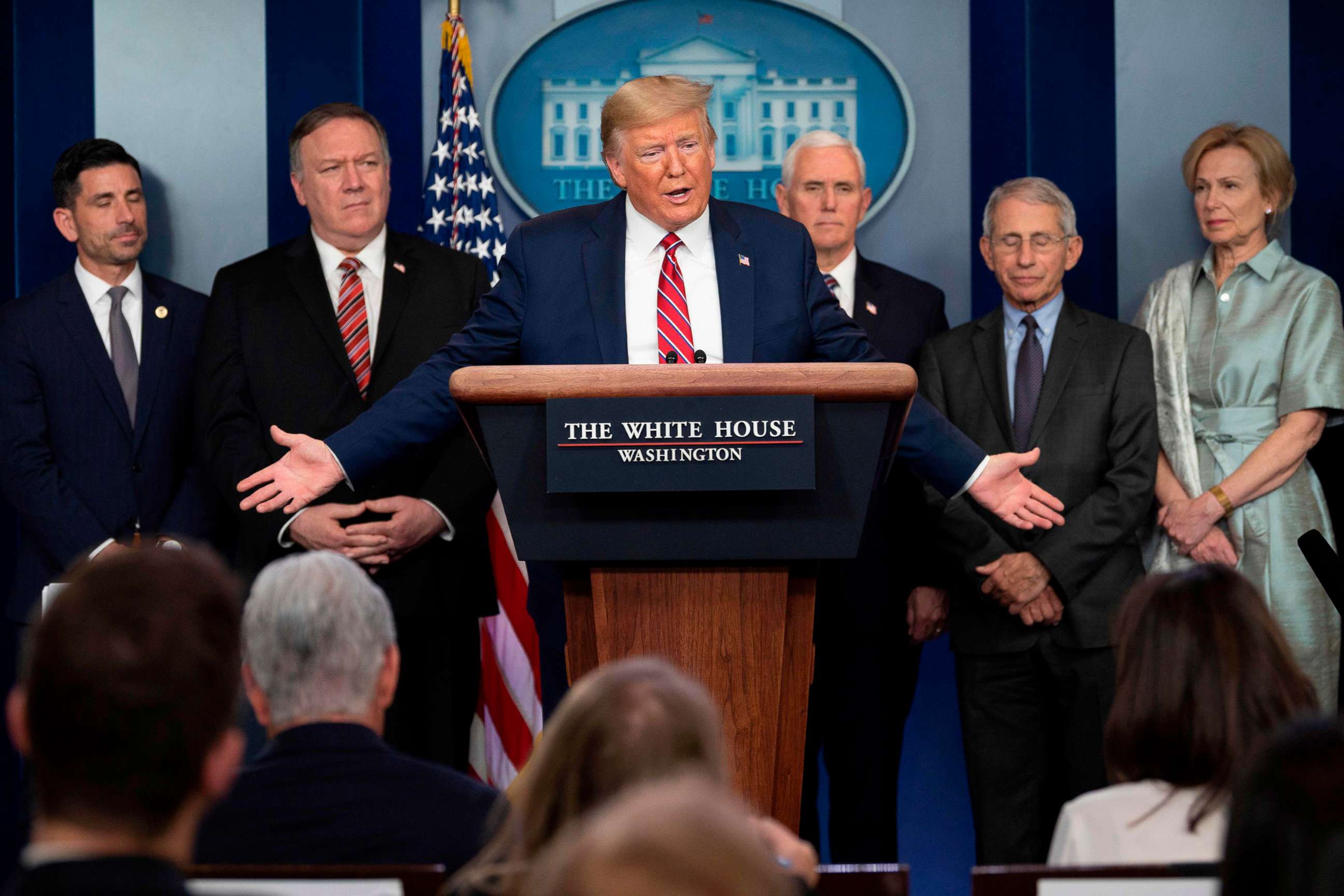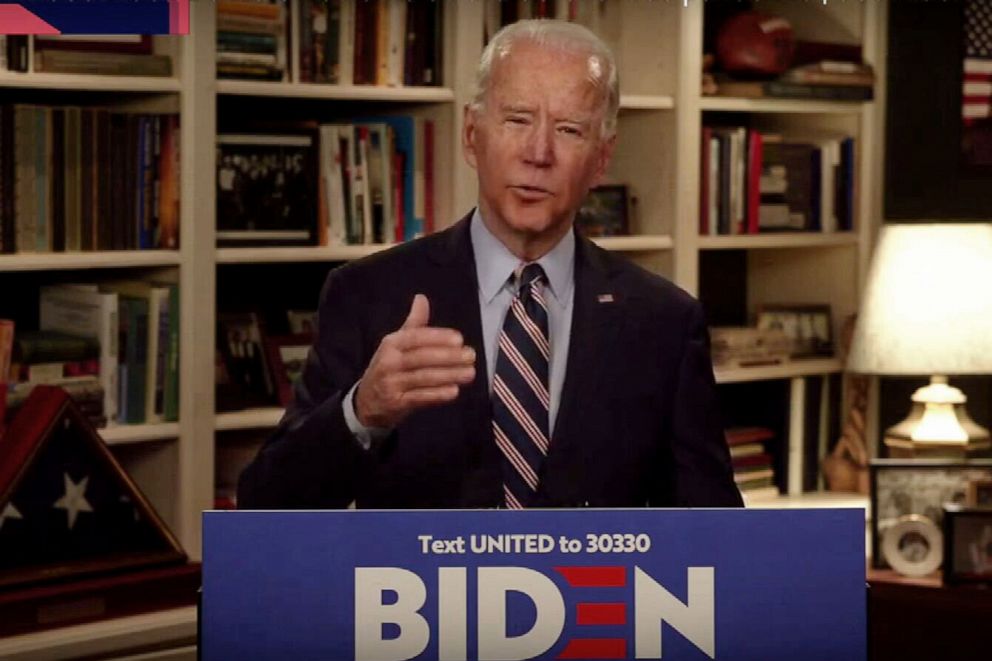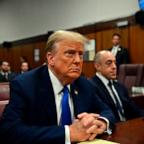Inside Trump’s reelection effort amid the pandemic: Digital canvassing, virtual trainings and marathon press briefings
Critics say Trump is using the virus briefings as a de facto rally replacement.
Olivia Brown’s phone banking script is another sign of the times.
Brown, a Arizona field organizer for the Trump campaign and Republican National Committee’s joint 2020 effort, says her calls to voters amid the coronavirus pandemic now include health checks and providing information and resources while also touting President Donald Trump’s response.
After working on the ground in the key state for around eight months, holding events at farmers' markets and doing door-to-door canvassing to ensure Trump keeps the crucial state red, Brown and hundreds of other Trump Victory field organizers have shifted their efforts entirely online.
“Instead of being out and about, we're connecting with voters from the safety of our home,” Brown said, adding that she’s been starting her mornings by making health checks on her team, making sure they don’t feel isolated while working from home.
Some staffers have even shopped for older volunteers who’ve been concerned about leaving the house amid the pandemic, according to the campaign.
The coronavirus outbreak has impacted all aspects of American life, including the 2020 election, presenting President Trump an unprecedented election year challenge.
Over the last few weeks, coronavirus infections have surged around the world, with the United States reaching crossing over 140,000 cases—a number that now leads all other countries. Hospitals are getting overwhelmed, states are demanding more resources, and the economy — the once crown jewel of the president’s reelection pitch— is crumbling, leaving industries upended and businesses shuttered around the country.
Critics say Trump’s response to the crisis has been a whiplash of inconsistency. At first, Trump downplayed the virus’ potential impact, saying in late January, “We have it totally under control. It’s one person coming in from China, and we have it under control. It’s going to be just fine.” But as the coronavirus’ impact surged in the U.S., the president argued he’d “always treated the Chinese Virus very seriously.”
The president has also downplayed requests by states asking for more resources to combat the virus. “I don’t believe you need 40,000 or 30,000 ventilators,” the president said, despite New York state and city officials telling the federal government they need far more than the Trump's administration is providing.
However, some of Trump’s early actions have been praised by experts like Dr. Anthony Fauci of the National Institutes of Health, who has lauded travel restrictions the president placed on China for slowing the virus despite some who criticized the move early on.
And last week, President Trump signed the largest relief bill in American history: a $2 trillion coronavirus aid package the government hope will slow the spread and aid local governments and businesses impacted by the virus.
Still, the president’s public response has been plagued by misstatements and haphazard suggestions of federal action that some have critics for causing even more panic among Americans.
On Sunday, New York Gov. Andrew Cuomo said that Trump’s off-the-cuff comment about a possible "short-term" quarantine of NY, NJ and parts of Conn, which the president later backed off of, “really panicked people.”
And until Sunday, Trump had been pushing the possibility of re-opening up the country again by Easter Sunday amid the still surging pandemic, despite health experts, and both Democrats and Republicans, warning the president that the move could be devastating. In a press conference over the weekend, Trump conceded the Easter Sunday goal, saying it was “aspirational,” and extended the distancing guidelines through April 30.
Campaigning amid a pandemic
It’s been nearly a month since the president has held a “Keep America Great” campaign rally packed with thousands adoring supporters, the centerpiece of his re-election effort. His team has instead shifted to a fully virtual campaign effort, moving hundreds of events online.
“We’ll get back to them,” Trump campaign communications director Tim Murtaugh told ABC News when asked about plans for future rallies. “Everybody is in this social distancing situation right now — all campaigns included — but it will pass.”

In the meantime, Trump has turned the lights back on in the long-dormant White House press briefing room. Nearly everyday amid the outbreak, in prime-time, the president has held rally-length press briefings on the coronavirus, which have garnered "Monday Night Football” level ratings, as he touted over the weekend.
And unlike Trump’s campaign rallies which networks had stopped covering live since the 2016 election, the president’s coronavirus briefings are mostly covered by the cable networks as they happen.
Critics have argued that amid an election year, Trump’s using the virus briefings as a replacement for his rallies. On top of delivering updates on the coronavirus response, at the briefings Trump often steers into topics that would be right at home at a campaign rally; attacking the media, ripping rivals like former Vice President Joe Biden, and even boasting about people being “jealous” they can’t get into the event— but instead of supporters waiting outside one of his rallies, he’s referencing journalists waiting outside the press briefing room.
The campaign has fired back, claiming Democrats and some in the media want to ignore the briefings, which also feature members of the coronavirus task force, because of the president’s rising poll numbers. They’ve also pointed out that some Democrats and journalists had been asking for press briefings to return after over a year-long hiatus.
Ultimately the briefings have provided the president the regular national stage he’s been lacking while rallies are on hold.
In terms of messaging, the Trump campaign has for the most part followed the White House’s lead around the coronavirus and the administration’s response. On social media, Trump’s team persistently pumps out video clips of the president’s briefings and comments touting his administration’s coronavirus response.
Over the weekend, the president, surrounded by American flags, saw the USNS Comfort off as it departed Naval Station Norfolk in Virginia for New York City, where it will serve as an emergency hospital for the city's coronavirus patients. In a matter of minutes, the Trump campaign had clipped, and pushed multiple segments from the president’s remarks all across social media.
On Friday, the Trump campaign posted a new digital ad that cobbled together some out-of-date and out-of-context quotes, which painted a misleadingly rosy picture of the ongoing pandemic.
The ad shows a clip from March 17th of New York Governor Chris Cuomo praising the president’s early response saying, “His team has been on it.” But the quote is 10 days old and since then the governor has criticized the federal government’s response multiple times.
The ad takes similar liberties with other clips, including one featuring MSNBC’s Joe Scarborough, who’s featured saying Trump “did what a president is supposed to do.” However, Scarborough was referring the the president’s tone during a press briefing over a week ago and has since harshly criticized the president and the federal government’s response.
The ad also comes after the president, members of his own campaign, and the RNC recently blasting Democrats, and specifically Joe Biden, for politicizing the coronavirus.
“Now the Democrats are politicizing the coronavirus,” Trump said at a rally in South Carolina last month. “This is their new hoax,” he added.
“Wartime president”
Amid the pandemic, Trump has cast himself as “wartime president” as he fights what he calls an “invisible enemy” during an election year. But experts say the self-prescribed marketing doesn’t fit.
“It's very different than a pandemic,” historian at Princeton University Julian E. Zelizer tells ABC News. “I think the nature of the enemy, the nature of what has to happen here in the U.S. to fight this enemy is very different than most of the wars that we've had.”

And Zelizer adds that Trump’s response to the pandemic so far has been influenced by factoring in his reelection prospects—a calculation he says is dangerous.
“The re-election is blending into what he does,” Zelizer said, adding that the daily coronavirus press briefings are “clearly efforts, when he speaks, to boast of what he's doing and to set up his argument of a successful wartime president against the disease. But we're deep into the war right now. We're not even close to the end.”
The president’s seesaw response and tone around the virus, according to Zelizer, is not only confusing but dangerous. He argues that Trump eyeing the possibility of declaring victory over the virus early could have had detrimental consequences.
“While it’s common for presidents to promise things are getting better in these types trying situations, I think in this case those kind of promises are much more lethal,” Zelizer said. “The kind of information swelling up out of the president fits his own re-election needs; he wants the economy to start again, he wants people to feel there's a lot of progress. But I think can have really terrible consequences that that traditional president lie doesn't have.”
Trump’s digital edge?
While the president remains off the campaign trail, the joint reelection effort between the Republican National Committee and the Trump campaign has barreled forward, shifting its efforts online.
Thanks to the team’s robust digital operation, which the RNC and the Trump campaign have spent years pouring millions into, Trump’s reelection team has an online strategy it can fall back as the pandemic grounds troops to their laptops.
“With our ability to engage with voters virtually and digitally, Trump Victory is not missing a beat, and we continue to be full steam ahead to November,” RNC Chief of Staff Richard Walters told ABC News in a statement.
In one of the first major tests of the re-election team’s digital capabilities, staffers and volunteers across the country hit the phones from the comfort of their own homes over the weekend.
The result: A record 1.5 million calls to voters in the first completely remote voter outreach effort carried out by the party, according to the RNC. The big number put the re-election team at 9 million voter contacts made to date, outpacing their efforts in 2016 and 2018, the RNC said.
In the week before, the Trump campaign and RNC were set to ramp up their ground game operation with a "national week of training” that had been in the works for months. But hundreds of events had to be moved into a virtual setting in a matter of days due to restrictions from the pandemic.
Using an application called “Trump Talk,” which the campaign introduced and trained staffers on prior to the outbreak, and video conference services like Zoom, the campaign was able to hold hundreds of volunteer trainings online, reaching nearly 50,000 signups on Trump Talk in the past week alone, the RNC said.
“Zoom was actually the platform that I and others had used to conduct online trainings in the past,” Arizona Trump Victory state director Drew Sexton told ABC News in an interview. Sexton, who notes he and members of his team had been trained on the telecommunication software since last year.
“From a training perspective, while I don’t know if [going virtual] has made things easier, folks who are here at home they are looking for things to do and making phone calls or being on an online training is not only one way people can feel engaged in the process but connect with other supporters right now,” Sexton said.
Sexton’s team had been prepared for March and April to be crucial months for in person campaigning with canvassing and trainings, and while he says the best results still come from face-to-face interactions with voters, the transition online also “represents a fertile ground for more rural areas” as the team pivots to relying on phone banking earlier than previously scheduled.
The Trump team’s built-in online base and digital empire could be one advantage while the campaign remains virtual.
“Trump is a natural online candidate in this setting,” Eitan Hersh, a political scientist at Tufts University, told ABC News.
Hersh, the author of “Politics Is for Power: How to Move Beyond Political Hobbyism, Take Action, and Make Real Change,” explained that not only does the president have the advantage of incumbency heading into the general election, but Trump’s particular headline-grabbing style and his team’s digital operation could produce a formidable combination for Democrats to overcome while the campaign trail remains online.
“If we’re imaging a campaign that’s waged strictly online than Trump may have advantages beyond just his incumbency,” Hersh said. “I think you would have a universal agreement across the political spectrum that between Trump and Biden, if one of those candidates has an advantage when it comes to being able to generate provocative appeals that are going to get clicks that lead to small dollar donations, it’s Trump.”
And the re-election team has a proven capability to rake in millions through online donations prior to the virtual shift, bringing in nearly 1.5 million individual donations during the 4th quarter alone last year, 98.78 percent of which were $200 or less, with an average donation of $40.87, according to the campaign.
The Trump campaign also has a significant social media and digital media footprint it can utilize during this time. The team’s YouTube channel has over 25 million views, campaign senior advisor Lara Trump hosts a weekly online show called “Real News,” and the team pumps out weekly campaign podcasts.
It’s a digital empire Trump’s team has been building since the day after he was inaugurated, an unprecedented head start.
“There's no question that that type of campaign footing has put [Trump] at an advantage,” Democratic strategist Jennifer Holdsworth tells ABC News.
“Trump has the resources because he has insisted on being on a campaign footing since the day he was inaugurated,” Holdsworth said, noting the president’s team has the capabilities to get the president’s message out to his supporters unlike Biden at the moment.
The Trump team took another step into the online campaign world last Thursday, hosting its first digital event with Lara Trump, national press secretary Kayleigh McEnany, and political director Chris Carr. The event lasted around 30 minutes, and beyond some technical issues that saw McEnany’s video briefly interrupted, the trio spent most of the event echoing the president and the White House’s defense of the coronavirus response.
According to the campaign, the event garnered over 945,000 viewers across all platforms. Lara Trump at the close of the event hinted that more could be on the way, but the Trump campaign’s schedule is currently empty.
Biden fights for air-time
The president’s potential general election rival in waiting, Joe Biden, has worked to break through the coronavirus news cycle while the president has dominated coverage during the pandemic with marathon press briefings and FOX News interviews.
Biden’s campaign is tasked with not only building out their own digital operation, the former vice president also remains in a primary battle with Sen. Bernie Sanders, who despite recent crushing loses and dismal nomination odds, has signaled he has no plans of dropping out anytime soon.
In response, Biden is hosting counter coronavirus pressers criticizing Trump’s handling of the pandemic from his new in-home television studio, he’s doing regular cable tv and Sunday show interviews, and on Monday he launched his own podcast.
Biden’s first few digital events were marked by gaffes, awkward moments, and technical difficulties— which the president’s team jumped on and worked to spread across social media to tar the former vice president and target his mental abilities.
Last week, Biden ran through a gauntlet of television interviews on ABC’s “The View,” CNN, and MSNBC. The Trump campaign and allies quickly jumped to target the vice president, circulating edited clips online highlighting some of Biden’s awkward moments.
“Looks like Sleepy Joe Biden's media tour is going well,” the Trump War Room account tweeted along with a clip of Biden having a strange exchange with MSNBC’s Nicole Wallace.
President Trump also retweeted a video that compiled clips of Biden coughing through his Tuesday media blitz, seeming to mock the former vice president for coughing amid the global pandemic: “The Democrat’s Best & Finest!” Trump wrote.
And while Biden continues to target the president’s response to pandemic, most Americans have approved of Trump’s actions so far, as an ABC News/Washington Post poll released on Friday shows that 51 percent of respondents view Trump’s management of the outbreak in the United States favorably.

Trump has also jumped from seven points behind Biden to a near tie, with the former vice-president ahead by 49% to 47% among registered voters.
And for the first time ever, the president’s job approval rating reached positive territory in the poll, with 48 percent of voters polled approving of the job Trump is doing, against 46 percent who disapprove.
Some experts point to Biden’s ability during the Democratic primary to overcome similar infrastructural advantages that rival Sen. Bernie Sanders had both online and on the ground as proof that he will fair well against the president despite some short comings.
“Biden’s rise from the ashes [during the primary] was not tied to money or a massive digital operation,” Vanderbilt political scientist John Geer tells ABC News.
“It is important he build a strong campaign for the Fall. But we now know that winning takes a lot more than dollars invested in advertising on TV and social media. The connection between message and the times will be what drives this election. Biden needs to continue to show competence and empathy—traits that he truly has and can help him unlock the Electoral College,” Geer said.
Holdsworth also echoed Geers argument.
“I'm not comparing [Trump and Sanders] but in terms of organization, Bernie has also been on the ground and investing millions in digital for more than four years,” Holdsworth said. “And he was crushed. I mean just annihilated.”
But with the campaign shifting online, it may be crucial for Biden to prove he can connect with supporters in unconventional ways to generate enthusiasm ahead of November—something the president has proven he can do and a task experts say could be a tall one for the former vice president.
Strong enthusiasm for Biden among Biden’s supporters is at just 24 percent according to a new ABC News/Washington Post poll — the lowest on record for a Democratic presidential candidate in 20 years.
President Trump on the other hand, has 53% percent of his supporters very enthusiastic, according to the poll, 29 points ahead of Biden.
“I don't think anyone looks at [Biden’s primary campaign] as an innovative campaign,” Hersh added when asked about Biden’s ability to compete online with the president.




